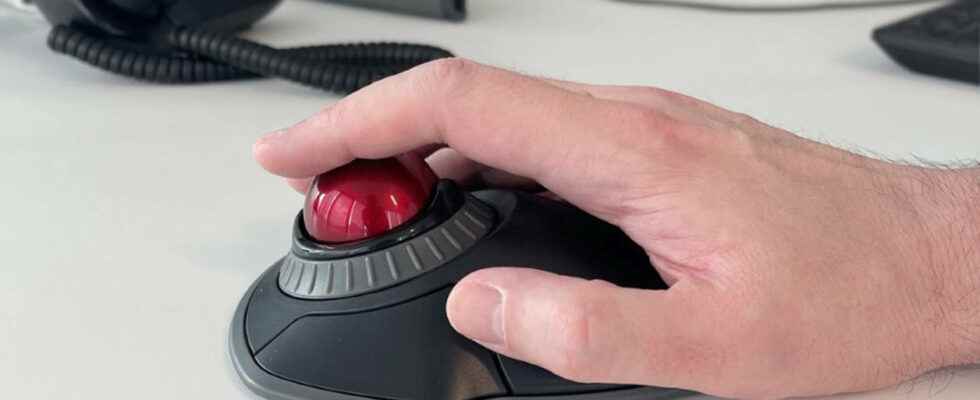Not happy with your mouse or touchpad? Why not switch to trackball? That’s what we did with this wireless Orbit model from Kensington and sold for around 70 euros.
The advantage of this trackball is that it can be used with both left and right hands, with a central ball 40 mm in diameter, two control buttons on each side and a notched wheel to control scrolling.
In our right-handed test, the thumb controls the left button, while the index and middle fingers spin the ball. The directory drives the dial, while the little finger takes care of the right button. Of course, an adaptation phase is necessary for mouse users and each person can choose a different finger configuration. But Kensington has sized its trackball well so that everything falls easily to hand. In addition, the wrist does not move, which avoids pain problems that can be encountered when using a mouse.
The choice between two wireless connection modes
Another advantage of the Orbit concerns the wireless connection. You have the choice between a classic Bluetooth connection, for example for a laptop computer, or a proprietary 2.4 GHz connection, thanks to the supplied USB dongle.

In both cases, the link is secured with 128-bit AES encryption. A smart guy can’t take control of the trackball without your knowledge.
A removable wrist rest
Kensington also delivers a wrist rest to provide even more comfort. But we regretted that it didn’t hug the Orbit case better, as shown in the photo below.

However, the wrist rest is very useful if you do not want your wrist to be in direct contact with the desk. We advise you to try it a few days before deciding whether to keep it or not.
Two batteries for power supply
How is the Orbit trackball powered? Alas by two AA size batteries. This is probably the only real weak point of the device. Kensignton ignores rechargeable batteries and above all does not offer an indicator to warn when the batteries are almost flat. It will therefore be necessary to have an additional set of batteries at hand.

Only consolation, a switch makes it possible to stop the trackball during long periods of non-use. Kensignton has also provided an automatic standby system after a certain period of inactivity. The switch also allows you to choose between the two wireless link modes.
Another button located under the Orbit is important: the sensitivity selector. The trackball has four settings: 400, 800, 1200 or 1600 dots per inch (dpi). Each press of the button switches to the next parameter and a diode flashes from one to four times to indicate the selected sensitivity, for example three times for 1200 dpi. For office use, we found the 800 dpi setting to be sufficient. Indeed, a higher setting causes the mouse arrow to move too much when you turn the ball.
We were convinced during office tasks, but the trackball is obviously much less suitable for gaming than the mouse. In particular, two fingers are monopolized by the rotation of the ball and you only have two control buttons. It is therefore no match for a real mouse for gamers.
A very good personalization program
If you want to customize the functions of the Orbit, Kensington offers the free KensingtonWorks program for macOS and Windows. This app allows you to assign a wide range of commands to the two buttons, as well as to pressing them simultaneously.

The manufacturer has provided for many scenarios, depending on the type of use (videoconferencing, web browsing, multimedia playback, office automation, etc.). Depending on the software you are using, the buttons will therefore have different behaviors.

You can also easily change the pointer (speed, acceleration) and scroll wheel settings. In addition to changing the speed and the direction (normal or backwards), the program offers to activate an inertial scrolling mode which turns out to be rather practical. Indeed, the scroll then takes into account the force with which you turn the wheel, which thus makes it possible to reach the bottom of a web page more quickly.
Also see video:
With its Orbit trackball, Kensington delivers a good wireless device for a reasonable price that will suit both right-handed and left-handed people to perform common tasks without the risk of hurting their hand or wrist. It’s just a pity that the manufacturer did not provide a rechargeable battery system or, at worst, an alert when the batteries begin to wear down.
